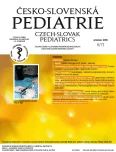Bone remodeling – the basic condition for treatment of forearm fractures in the growing skeleton
Authors:
T. Pešl; P. Havránek
Authors‘ workplace:
Klinika dětské chirurgie a traumatologie 3. LF UK, Thomayerova nemocnice, Praha
Published in:
Čes-slov Pediat 2018; 73 (8): 475-479.
Category:
Overview
Objective:
The bone remodeling belongs to the cornerstones of bone healing in children. Recently its importance and benefit is overlooked and dominate the more „aggressive“ and „effective“ way of treatment. The aim of the study is to bring the role of bone remodeling back into account in case of forearm fracture treatment in children.
Methods:
A clinical cohort of our department from a year 2017. Children with uncomplicated forearm fractures with clinical significant fragment displacement were evaluated. Entrance condition to the study was presence of the physis in proband skeleton. The cut-off conditions were compound fracture or refracture, patients with multiple injury, patients with Monteggio, or Galeazzi lesion. These injuries do affect the way of the forearm fractures treatment. We study the fracture location, patient´s age, treatment methods and the results of treatment.
Results:
During the year 2017 3392 children were treated in our department because of skeletal injury. Three hundred and forty six of them suffered uncomplicated forearm fracture. Injury of the distal radius was treated without surgery in absolute majority in all age groups. On the other hand injury of the radial neck or the ulnar olecranon were treated almost in all cases by osteosynthesis. In case of forearm shaft fractures the proportion of osteosynthesis rised according to age group.
Conclusion:
The younger the patient is the more conservative way of treatment of the forearm fracture is used, thanks to bone remodeling. For uncomplicated distal radial injury is non-operative way of treatment fully adequate. Only displaced intraarticular fractures are absolutely indicated for osteosynthesis. The same is valid for displaced radial neck or olecranon fractures. In unstable forearm shaft fracture there are only relative indication for osteosynthesis, which rise according to the patients age.
KEY WORDS:
forearm fracture, child, physis, bone remodeling
Sources
1. Havránek P. Dětské zlomeniny. 2. vyd. Praha: Galén, 2013: 2–4.
2. Ogden JA. Skeletel Injury in the Child. New York: Springer, 2000.
3. Bartoníček J, Heřt J. Základy klinické anatomie pohybového aparátu. Praha: Maxdorf, 2004: 38–55.
4. Dolan M, Waters PM. Fractures and dislocations of the forearm, wrist and hand. In: Green NE, Swiontkowski MF (eds). Skeletal Trauma in Children. Philadelphia: Saunders-Elsevier, 2009: 159–206.
5. Jordan RW, Westacott D, Srinivas K, Shyamalan G. Predicting redisplacement after manipulation of paediatric distal radius fractures: the importance of část moulding. Eur J Orthop Traumatol 2015; 25: 841–845.
6. Wendling-Keim DS, Wieser B, Dietz HG. Closed rediction and immobilization of displaced distal radial fractures. Method of choice for the treatment of children? Eur J Trauma Emerg Surg 2015; 41: 421–428.
7. Ramoutar DN, Shivji FS, Rodrigues JN, Hunter JB. The outcomes of displaced paediatric distal radius fractures treated with percutaneous Kirschner wire fixation: a review of 248 cases. Eur J Orthop Surg Traumatol 2015; 25: 471–476.
8. Rang M, Stearns P, Chambers H. Radius and ulna. In: Wenger DR, Pring ME. Rang´s Children´s Fractures. 3rd ed. Philadelphia: Lippincott Williams & Wilkins, 2005: 139–143.
9. Métaizeau JP, Lascombes P, Lemelle JL, et al. Reduction and fixation of displaced radial neck fractures by closed intramedullary pinning. J Pediatr Orthop 1993; 13: 355–360.
10. Prathapkumar KR, Garg NK, Bruce CE. Elastic stable intramedullary nail fixation for severy displaced fractures of the neck of the radius in children. J Bone Joint Surg 2006; 88B: 358–361.
11. Monson R, Black B, Reed M. A new closed reduction technique for the treatment of radial neck fractures in children. J Pediatr Orthop 2009; 29: 243–247.
12. Havránek P. Dětské zlomeniny. 2. vyd. Praha: Galén, 2013: 168–186.
13. Mehlman CT, Wall EJ. Injuries to the shaft of radius and ulna. In: Beaty JH, Kasser JR (eds). Rockwood and Wilkins´ Fractures in Children. Philadelphia: Lippincott Williams & Wilkins, Wolters Kluwer, 2010: 347–400.
14. Schmittenbecher PP. State-of-the-art treatment of forearm shaft fractures. Injury 2005; 36 (Suppl 1): A25–A34.
15. Eismann EA, Parikh SN, Jain VV. Rereduction for redisplacement of both-bone forearm shaft fractures in children. J Pediatr Orthop 2016; 36: 405–409.
16. Sinikumpu JJ, Serlo W. The shaft fractures of the radius and ulna in children: current concepts. J Pediatr Orthop B 2015; 24: 200–206.
17. Sinikumpu JJ, Victorzon S, Antila E, et al. Nonoperatively treated forearm shaft fractures in children show good long-term recovery. A population-based matched case-control study with mean 11 years of follow-up. Acta Orthop 2014; 85: 620–625.
18. Havránek P. Dětské zlomeniny. 2. vyd. Praha: Galén, 2013: 36–44.
Labels
Neonatology Paediatrics General practitioner for children and adolescentsArticle was published in
Czech-Slovak Pediatrics

2018 Issue 8
- What Effect Can Be Expected from Limosilactobacillus reuteri in Mucositis and Peri-Implantitis?
- The Importance of Limosilactobacillus reuteri in Administration to Diabetics with Gingivitis
Most read in this issue
- Focal nodular hyperplasia in children – diagnostics and treatment
- Necrotizing enterocolitis in the Perinatological Centre of the University Hospital Hradec Králové in 2010–2017
- Bone remodeling – the basic condition for treatment of forearm fractures in the growing skeleton
- The current incidence of coronary heart disease risk factors in children in the Czech Republic in 2016
